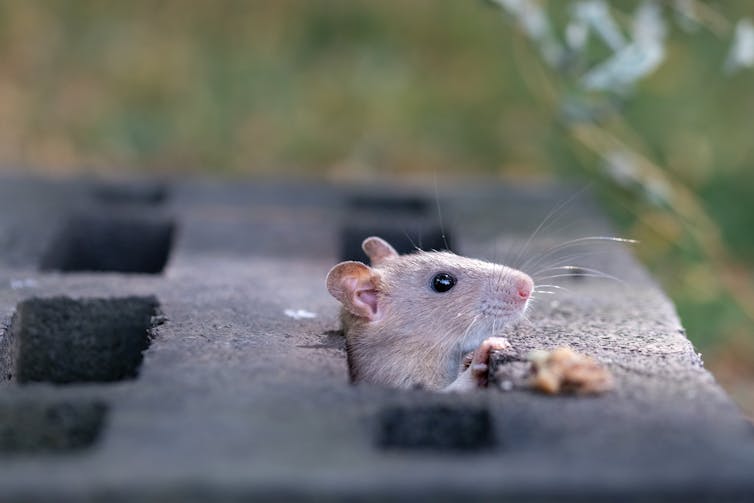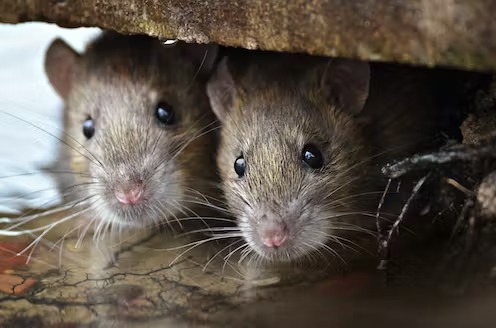Rats have a somewhat unfortunate tendency to enjoy living where people live. That’s how a biologist tried to explain people’s hatred for the rodents in a television news feature about rats gnawing electrical cables in parked cars in the southern Swedish town of Malmö.
The brown rat, Rattus norvegicus, is one of the species best adapted to modern society. These rats have followed humans across the world to become one of the most abundant mammals, spreading from their native distribution in northern China and Mongolia and reaching Europe in the 1500s, possibly even earlier. Black rats, however, arrived in Europe as early as the 1st century AD.
Today almost all wild brown rats are synanthropic, meaning they live in close association with humans, eating our leftovers and using human structures for shelter. The relationship between rats and humans is one of commensalism, a word derived from the Latin term “commensal”, meaning “eating at the same table”.
Throughout the centuries, rats have been cast as humanity’s dark shadow. Rats have had an enormous impact on human civilisation, not least through the spread of diseases. They have long been associated with dirt, death and destruction. In medieval Europe people loathed rats for their so-called brutishness, seemingly limitless sexual appetite and fecundity. But their huge numbers and adaptability mirrors humans’ evolutionary success.
They have spread with wars and European imperialism to colonised territories in the Americas as well as Africa and Australia. Rats thrive in the trenches of modern warfare even today.
A social and empathetic animal
Real rats are far from the despicable creatures they often are made out to be. Several studies have shown that rats have powerful empathy.
These animals can share the emotional state of others, which in psychology is called emotional contagion. Research has shown that when a rat sees another rat in distress, the neural structures activated in that rat’s brain closely resembles those activated in humans brains when feeling empathy for pain of others.
One experiment showed that rats will release a fellow rat from an unpleasant cage even if they are not rewarded for it. And if given chocolate treats afterwards, the free rat would usually save at least one treat for the former captive.
This selfless behaviour comes from rats’ socially complex lives in family groups of multiple generations. They form lifelong bonds with other rats and share socially learned skills, such as foraging techniques, across generations. This means rats have a form of culture.
A study from 2023 even showed that rats can imagine places and things that aren’t in front of them at the time. In experiments rats were shown to navigate a space in their thoughts, that they have previously explored. As in the studies of empathy, researchers demonstrated this by comparing the regions in the rat’s brains that were activated to those that are activated when humans think about navigating their way through places they have visited.
This ability to imagine also suggests that rats have a sense of past and future.
Living and dying with rats
With this in mind, human ways of dealing with rats seem cruel. The most common chemical method for rat control is anticoagulants, which cause fatal internal bleeding one to two weeks after a rat eats the poison. Since rats are both socially intelligent and cautious, they prefer to sample unfamiliar food and then wait to see if it makes them or other rats sick.
It’s called poison shyness. With anticoagulants however, the time between consumption of the bait and the rat dying is so long that they don’t usually associate it with their feeding habits.
The human motivation for learning about rats has often been the desire to kill them. The foremost experts in wild rat behaviour are their exterminators. And yet, current methods for controlling wild rat populations are not very effective.
Some rats have developed resistance to the poisons and are able to eat it and survive. Trapping them is notoriously difficult, and they often recolonise the territory from which they have been removed.
Global urbanisation is probably only going to bring humans into closer contact with rats, and killing rats the way it is done today isn’t ethical.

It’s time to consider if there are less violent ways of living alongside rats. TashaBubo/Shutterstock
Instead, we should consider other strategies, like the ones explored by the Urban Rat Project at the University of Helsinki. Here researchers from different disciplines are trying to get a deeper understanding of conflicts between rats and humans. They are studying both species and their interactions, in hope of a future with less bloody human-rat relations. The project has spotted that places in urban areas where people feed birds tend to attract rats as well – which people then try to eradicate using poison or traps.
Research has also suggested that with increased knowledge about rats and their behaviour people tend to develop a more positive attitude towards them. So more knowledge of wild rats’ social behaviour is needed. And humans need to manage their own behaviour to avoid conflict with rats.
A good place to start would be reducing food waste and stop leaving leftovers out unsecured. Less rats around human food sources, for example, and more knowledge about their behaviour would mean a lower risk of diseases spreading from rats to humans, as well as from humans to rats.
Humanity’s future is with the rat, a social and empathetic animal. So it’s time we understood our shadows.



 A man scouring Google Earth found a mysterious scar in the Australian outback – and now scientists know what caused it
A man scouring Google Earth found a mysterious scar in the Australian outback – and now scientists know what caused it  Around 9,000 species have already gone extinct in Australia and we’ll likely lose another this week – new study
Around 9,000 species have already gone extinct in Australia and we’ll likely lose another this week – new study  A new model accurately predicts the migration of humpback whales – and may help them survive climate change
A new model accurately predicts the migration of humpback whales – and may help them survive climate change  Elon Musk Offers Starlink Aid Amid LA Wildfires, Criticizes California's Crisis Management
Elon Musk Offers Starlink Aid Amid LA Wildfires, Criticizes California's Crisis Management  California Wildfires Ignite Political Storm Amid Crisis
California Wildfires Ignite Political Storm Amid Crisis  AI weather models can now beat the best traditional forecasts
AI weather models can now beat the best traditional forecasts  Wildfires ignite infection risks, by weakening the body’s immune defences and spreading bugs in smoke
Wildfires ignite infection risks, by weakening the body’s immune defences and spreading bugs in smoke  Southern California is extremely dry, and that’s fueling fires − maps show just how dry
Southern California is extremely dry, and that’s fueling fires − maps show just how dry  Tropical forests can be revived after logging – if they’re not turned into oil palm plantations
Tropical forests can be revived after logging – if they’re not turned into oil palm plantations  Sediment is a time capsule that shows how past climate change altered our landscapes – and hints at their future
Sediment is a time capsule that shows how past climate change altered our landscapes – and hints at their future  How is Antarctica melting, exactly? Crucial details are beginning to come into focus
How is Antarctica melting, exactly? Crucial details are beginning to come into focus 
































